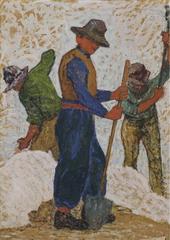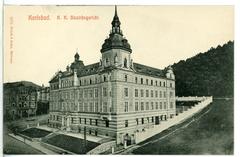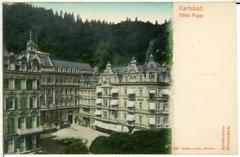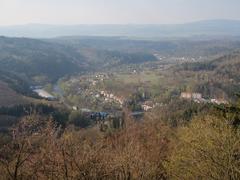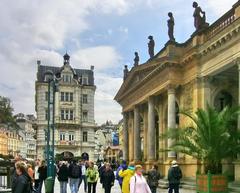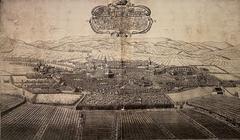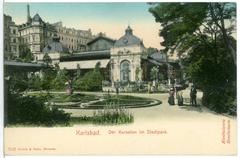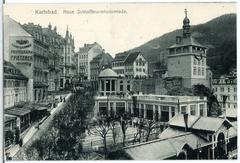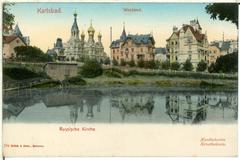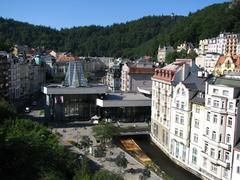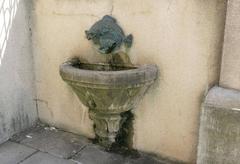
Japonský Pavilon Karlovy Vary: Visiting Hours, Tickets, and Visitor Guide
Date: 04/07/2025
Introduction
The Japonský Pavilon, or Japanese Pavilion, was once a remarkable symbol of Karlovy Vary’s industrial ambition and cosmopolitan spa culture. Although the physical structure no longer exists, its legacy endures in local museums, historical records, and the spirit of cultural exchange that continues to shape the town. This comprehensive guide explores the pavilion’s origins, architectural significance, historical context, and practical information for visitors seeking to immerse themselves in Karlovy Vary’s unique heritage (czwiki.cz; cs.wikipedia.org; Karlovy Vary Official Tourism; Passporter).
Table of Contents
- Introduction
- Origins and Construction of the Japonský Pavilon
- Architectural Design and Function
- International Recognition
- Decline, Demolition, and Legacy
- Visiting Today: What Remains and How to Explore
- Practical Visitor Information
- Frequently Asked Questions (FAQ)
- Summary and Final Tips
- References and Further Reading
Origins and Construction of the Japonský Pavilon
The Japonský Pavilon was conceived in the late 19th century, during a period of industrial growth and rising international prestige for Karlovy Vary. Entrepreneur Karel Knoll, a significant figure in the region’s porcelain industry, envisioned the pavilion as both a commercial showroom and a leisure destination. Constructed between 1885 and 1886 on an island in the now-vanished Mlýnský pond (currently the Rolava recreational area), the pavilion showcased the finest local porcelain and served as a social hub for European nobility and spa guests (czwiki.cz; cs.wikipedia.org).
Architectural Design and Function
Design Influences
The pavilion embodied the Japonisme trend sweeping through Europe at the time, featuring an exotic square floor plan, three towers with porcelain-tiled roofs, and walls made from parian porcelain adorned with life-sized images of birds and Japanese landscapes by artists Hermann Zimmermann and Wilhelm Jessl. The structure’s aesthetic appeal was complemented by its integration with a tranquil pond, complete with water lilies, swans, and opportunities for boating and fishing (czwiki.cz).
Social and Cultural Function
Inside, visitors could sample Oriental teas and relax in a tearoom staffed by attendants in Japanese kimonos. The pavilion functioned as both a retail space for Knoll’s porcelain wares and a cultural venue for socializing and leisure, reinforcing Karlovy Vary’s reputation as a luxurious and cosmopolitan spa destination (cs.wikipedia.org).
International Recognition
In 1900, the Japonský Pavilon was disassembled and transported to Paris for exhibition at the Exposition Universelle (World’s Fair), where it garnered international attention for its innovative design and craftsmanship. Its participation in this globally significant event underscored Karlovy Vary’s aspirations and the excellence of its porcelain industry (cs.wikipedia.org).
Decline, Demolition, and Legacy
After returning from Paris, the pavilion continued to function as a symbol of prestige until 1905, when a new showroom was constructed. Over the decades, especially from the late 1930s onward, maintenance waned due to war, economic hardship, and shifting political priorities. The ornate structure gradually deteriorated and was officially demolished in 1953 (czwiki.cz; cs.wikipedia.org; Wikipedia: Karlovy Vary).
The loss of the Japonský Pavilon was emblematic of broader trends in Central Europe, where many ornate historical buildings were removed or neglected during periods of political upheaval and urban modernization (Passporter).
Visiting Today: What Remains and How to Explore
Is the Japonský Pavilon Still Standing?
No physical trace of the pavilion remains today. Its former site is now part of the Rolava swimming and recreation area in the Rybáře district.
What Can Visitors Experience?
Although the original building is gone, visitors can:
- Stroll through the Rolava area, now a public recreation zone.
- Explore local museums, such as the Karlovy Vary Museum, which feature porcelain exhibits and historical displays.
- Join guided walking tours that discuss the pavilion’s history and lost landmarks of Karlovy Vary.
Nearby Historical Sites
Enhance your visit by exploring:
- The Mill Colonnade and Park Colonnade, icons of spa architecture (Wikipedia)
- The Hot Spring Colonnade and Moser Glassworks Museum
- Dvořák Park and the scenic Teplá river promenade
Practical Visitor Information
- Admission and Hours: The former pavilion site is open to the public; no tickets or specific hours apply. Museums and attractions in the area have their own opening times and admission fees—consult their official websites for current details.
- Accessibility: The Rolava area and most central attractions are accessible by public transport or taxi from the city center. Most sites are walkable and wheelchair accessible.
- Visiting Tips: Consider visiting during spring or autumn for pleasant weather and fewer crowds. Use the Karlovy VARY REGION CARD for discounts on attractions.
Frequently Asked Questions (FAQ)
Q: Can I visit the Japonský Pavilon today?
A: The pavilion was demolished in the mid-20th century. The site is now part of the public Rolava area, and no physical remnants remain.
Q: Where can I learn more about the pavilion and Karlovy Vary’s porcelain industry?
A: Local museums like the Karlovy Vary Museum and porcelain factory exhibitions provide historical context and artifact displays.
Q: Are there tours that discuss the Japonský Pavilon?
A: Yes, some walking tours of Karlovy Vary include lost landmarks such as the Japonský Pavilon.
Q: What other historical sites should I visit?
A: Notable sites include the Mill Colonnade, Park Colonnade, Grandhotel Pupp, and the Moser Glassworks Museum.
Summary and Final Tips
The Japonský Pavilon, though lost, remains a vivid symbol of Karlovy Vary’s golden era of spa culture, international influence, and artistic innovation. Its story, intertwined with the Japonisme movement and the entrepreneurial vision of Karel Knoll, reflects the city’s historical openness to global trends and its enduring commitment to cultural exchange. Visitors today can connect with this legacy through museum exhibits, guided tours, and the tranquil ambiance of the Rolava area. For a deeper exploration of Karlovy Vary’s rich heritage—including the pavilion’s story and related sites—consult the official tourism portal and dedicated cultural apps like Audiala (Karlovy Vary Official Tourism; Audiala; Passporter).
References and Further Reading
- Japonský Pavilon, czwiki.cz
- Japonský Pavilon (Karlovy Vary), cs.wikipedia.org
- Karlovy Vary Official Tourism
- Passporter: Things to Do in Karlovy Vary
- Wikipedia: Karlovy Vary
- Audiala Mobile App
For images and historical illustrations, visit the Japonský Pavilon category on Wikimedia Commons.





